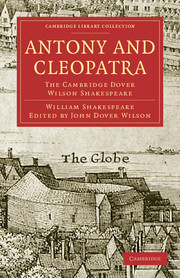THE COPY FOR THE TEXT OF 1623
Published online by Cambridge University Press: 07 September 2010
Summary
Shakespeare's Manuscript
In an Introduction to the facsimile of this text issued by Messrs Faber and Faber in 1929 I suggested that the copy for F., the only original we have of the play, was Shakespeare's own manuscript. F. certainly contains a number of spellings of an unusual or, by 1623, of an archaic character, such as are either found in ‘good’ quarto and other F. texts, or are of similar type to those found therein. Here are a handful: one (on) 1. 1. 39; how (ho!) 1. 2. 114; to (too) 2. 5. 8, 3. 1. 15; too (to) 5. 1. 56, etc.; redding (residing) 1.3.103, 2.2.37; hard (heard) 2. 2. 223; arrant (errand) 3.13. 104; in (e'en) 4.15.73; triumpherate (triumvirate) 3. 6. 28. The last two look like misprints. Yet ‘in’ (e'en) occurs again in Merch. (Q1) 3. 5. 20,Rom. (Q2) 5. 1. 24, Err. (F.) 2. 2. 101, and All's Well (F.) 3. 2. 18; and so can hardly be anything but a Shakespearian spelling. As for the remarkable ‘triumpherate’, L.L.L. (Q1) which like Antony and Cleopatra was almost certainly printed from a Shakespearian MS. lends its support in ‘triumpherie’ for ‘triumviry’ Equally noteworthy is the spelling or perversion of the classical names. Working presumably with North under his eye, Shakespeare was nevertheless restrained by no habits of ‘correctness’ or consistency so long as the names sounded all right on the stage.
- Type
- Chapter
- Information
- Antony and CleopatraThe Cambridge Dover Wilson Shakespeare, pp. 124 - 130Publisher: Cambridge University PressPrint publication year: 2009First published in: 1950

